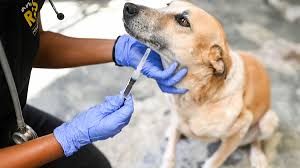Rabies, scientifically known as Lyssavirus, is a serious viral infection that affects the nervous system of mammals. This disease is caused by a virus that belongs to the Rhabdoviridae family. Rabies is mainly transmitted through the saliva of infected animals, commonly through bites. Once symptoms appear, it is often fatal, making it crucial to understand its nature and take preventive measures.
The virus primarily targets the central nervous system, leading to inflammation of the brain. This inflammatory process is responsible for the characteristic symptoms of rabies, including fever, headache, and general discomfort. As the infection progresses, more severe symptoms emerge, such as hallucinations, paralysis, and difficulty swallowing.
One of the key features of rabies is its zoonotic nature, meaning it can be transmitted between animals and humans. Wild animals like bats, raccoons, and foxes are common carriers, and domestic animals like dogs and cats can also contract and transmit the virus. Human infections are often the result of close contact with an infected animal, most commonly through bites.
Prevention is essential in managing rabies, and vaccination plays a crucial role. Vaccinating pets, particularly dogs, helps control the spread of the virus. Additionally, immediate and thorough cleaning of wounds after potential exposure to saliva can reduce the risk of infection. In cases of confirmed exposure, post-exposure prophylaxis, involving a series of rabies vaccinations, is recommended to prevent the onset of symptoms.
Rabies is a global concern, with the World Health Organization estimating tens of thousands of human deaths annually, primarily in regions where the virus is prevalent among animals. While some countries have successfully implemented widespread vaccination programs, challenges persist in controlling rabies in certain regions, leading to continued efforts to raise awareness and improve preventive measures.
Additionally, understanding the basics of rabies is crucial for both animal and human health. Vigilance in pet vaccinations, responsible handling of potential exposures, and awareness campaigns are essential components in the ongoing battle against this deadly viral infection.
Read Also: Economic Importance and Uses of Cattle Meat
Animals Affected by Rabies (Lyssavirus)

Rabies can affect a wide range of mammals, both wild and domesticated. Commonly affected animals include mammals that are known to serve as reservoirs for the virus. Here are some examples:
1. Dogs: Domestic dogs are one of the most significant sources of rabies transmission to humans. Vaccination campaigns targeting dogs play a crucial role in preventing the spread of the virus.
2. Bats: Various species of bats are natural carriers of the rabies virus. While not all bats carry the virus, those that do can transmit it through bites or scratches.
3. Raccoons: Wild raccoons can harbor the rabies virus and pose a risk of transmission to other animals and humans, particularly in regions where raccoons are prevalent.
4. Foxes: Foxes are known to be susceptible to rabies, and their interaction with domestic animals and humans can lead to the spread of the virus.
5. Skunks: Rabies is also found in skunks, and they can transmit the virus through bites. Skunks are more likely to be rabid in certain geographic regions.
6. Cats: Domestic cats can contract rabies, although they are less commonly affected than dogs. Vaccinating cats is important for preventing the transmission of the virus.
7. Cattle: Livestock, including cattle, can be affected by rabies. This poses a risk to both the animals and those who work with them.
8. Wildlife: Various other wildlife species, such as coyotes, mongooses, and certain rodents, can carry and transmit the rabies virus.
It’s important to note that the susceptibility to rabies varies among species, and not all individuals within a species will be infected. The transmission of rabies usually occurs through the saliva of an infected animal, commonly through bites, scratches, or open wounds. Understanding the range of animals that can be affected is crucial for implementing effective prevention and control measures.
Damages Caused by Rabies
Rabies can cause significant damage to both animals and humans due to its impact on the nervous system. Here are some of the damages associated with rabies:
1. Neurological Damage: Rabies primarily affects the central nervous system, causing inflammation of the brain. This can result in neurological symptoms such as confusion, aggression, hallucinations, and paralysis.
2. Behavioral Changes: Infected animals, especially mammals like dogs, may exhibit abnormal behaviors. For example, a once-friendly pet may become aggressive or overly timid. This behavioral change is a consequence of the virus affecting the brain.
3. Fatality: Rabies is almost always fatal once clinical symptoms appear. The damage to the nervous system is irreversible, leading to death within a relatively short period after the onset of symptoms.
4. Transmission Risk: Infected animals can transmit the virus through bites, scratches, or exposure to their saliva. This poses a risk to other animals and humans, especially in regions where rabies is prevalent.
5. Impact on Wildlife: Rabies can have ecological consequences by affecting wildlife populations. When the virus spreads among wild animals, it can lead to imbalances in ecosystems and affect biodiversity.
6. Economic Impact: The economic impact of rabies includes costs associated with prevention, control measures, and medical treatment. Losses in the agricultural sector may also occur due to the death of livestock.
7. Psychological Impact: For individuals who have been exposed to rabies, the psychological impact can be profound. Fear of developing symptoms, anxiety during the post-exposure prophylaxis treatment, and the emotional toll of losing a pet or witnessing the effects of rabies in animals can be distressing.
8. Public Health Concerns: Rabies is a significant public health concern globally. In areas where the virus is endemic, human deaths resulting from rabies remain a serious issue, emphasizing the importance of preventive measures and awareness campaigns.
Understanding the damages caused by rabies underscores the importance of vaccination programs for animals, responsible pet ownership, and prompt medical intervention in cases of potential exposure. Preventing the spread of rabies requires a multi-faceted approach to protect both animal and human populations.
Read Also: The Reproductive Rate of Cattle
Control and Preventive Measures

Controlling and preventing the spread of rabies involves a combination of public health strategies, vaccination programs, and responsible pet ownership. Here are key measures:
1. Vaccination Programs: Implementing widespread vaccination programs for domestic animals, especially dogs and cats, is crucial. Regular vaccination helps create a barrier against the spread of rabies within animal populations and reduces the risk of transmission to humans.
2. Wildlife Vaccination: In some regions, wildlife vaccination programs may be employed to target reservoir species such as raccoons, foxes, and bats. This approach helps curb the spread of rabies within wild animal populations.
3. Stray Animal Control: Managing and controlling stray animal populations, particularly in urban areas, is important for preventing the transmission of rabies. This can involve animal control measures, including sterilization and vaccination campaigns.
4. Education and Awareness: Public education about rabies transmission, symptoms, and preventive measures is essential. Awareness campaigns can encourage responsible pet ownership, prompt reporting of animal bites, and understanding the importance of seeking medical attention after potential exposure.
5. Post-Exposure Prophylaxis (PEP): Timely administration of post-exposure prophylaxis (PEP) is critical for individuals who have been bitten or scratched by an animal suspected of carrying rabies. PEP involves a series of rabies vaccinations and, in some cases, rabies immune globulin.
6. Animal Quarantine: Quarantine measures for animals that may have been exposed to rabies help prevent the potential spread of the virus. This is particularly important for imported animals or those with unknown vaccination status.
7. Monitoring and Surveillance: Regular monitoring of rabies cases in both animals and humans is essential for early detection and response. Surveillance systems help identify areas where the virus is prevalent and guide targeted intervention strategies.
8. Research and Innovation: Continued research into rabies prevention and control methods, including the development of new vaccines and treatment options, contributes to more effective strategies for managing the disease.
9. International Collaboration: Given the global nature of rabies, international collaboration is crucial. Sharing knowledge, expertise, and resources among countries helps address challenges and improve overall control efforts.
10. Community Involvement: Engaging communities in rabies prevention efforts fosters a sense of responsibility and ownership. Encouraging reporting of stray animals, supporting vaccination campaigns, and promoting responsible interactions with wildlife contribute to overall community health.
By combining these measures, communities and governments can work towards controlling and preventing the spread of rabies, ultimately reducing the impact of this deadly viral infection on both animal and human populations.
Frequently Asked Questions (FAQs) About Rabies (Lyssavirus)
Q1: What is rabies?
A: Rabies is a viral infection caused by the Lyssavirus, primarily affecting the nervous system of mammals. It is often transmitted through bites from infected animals.
Q2: Which animals can carry and transmit rabies?
A: Various mammals can carry and transmit rabies, including dogs, bats, raccoons, foxes, skunks, and certain rodents. Wild and domesticated animals may be potential carriers.
Q3: How is rabies transmitted?
A: Rabies is typically transmitted through the saliva of an infected animal, commonly through bites. Scratches or exposure to an infected animal’s open wound or mucous membranes can also pose a risk.
Q4: What are the symptoms of rabies in animals?
A: Symptoms in animals may include behavioral changes, aggression, paralysis, and difficulty swallowing. Rabid animals may also exhibit abnormal vocalizations.
Q5: Can rabies be transmitted from humans to animals?
A: Yes, rabies can be transmitted from humans to animals through bites or exposure to infected saliva. However, human-to-animal transmission is rare.
Q6: Is rabies curable?
A: Once clinical symptoms appear, rabies is almost always fatal. However, immediate and appropriate post-exposure prophylaxis (PEP) can prevent the onset of symptoms if administered shortly after potential exposure.
Q7: How can I protect my pets from rabies?
A: Vaccinating pets, especially dogs and cats, is crucial for their protection and for preventing the spread of rabies. Avoiding contact with potentially infected wildlife and practicing responsible pet ownership also reduce the risk.
Q8: What should I do if bitten by an animal?
A: Clean the wound thoroughly with soap and water and seek immediate medical attention. Post-exposure prophylaxis (PEP) may be administered to prevent the onset of rabies symptoms.
Q9: Is rabies common worldwide?
A: Rabies is found on every continent except Antarctica. Its prevalence varies, with higher incidences in certain regions. In some developed countries, successful vaccination programs have reduced the number of cases.
Q10: Can you get rabies from a dead animal?
A: Transmission from a dead animal is unlikely, but caution is advised. Contact with saliva or neural tissues should be avoided, and it’s essential to report any potential exposure to health authorities.
Read Also: Potato Farming Guide – 7 Tips to Grow Sacks Full of Potatoes

